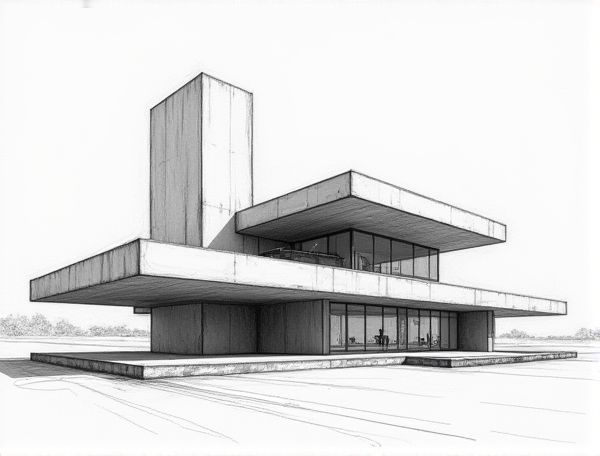
Photo illustration: Futuristic home design with kinetic façade systems
Futuristic home design embraces kinetic facade systems that adapt dynamically to environmental changes, improving energy efficiency and aesthetic appeal while enhancing occupant comfort. Discover how integrating these innovative technologies can transform your living space by reading more in the article.
Introduction to Futuristic Home Design
Explore the innovative features of futuristic home design that blend smart technology with sustainable materials, creating living spaces that adapt to your lifestyle. Advanced automation systems enhance energy efficiency and security, while minimalist aesthetics maximize comfort and functionality. Your home transforms into a seamless integration of cutting-edge design and eco-friendly solutions for modern living.
What Are Kinetic Façade Systems?
Kinetic facade systems are dynamic architectural elements designed to adapt and respond to environmental conditions such as sunlight, wind, and temperature. These systems enhance energy efficiency and aesthetic appeal by adjusting their position or shape in real-time, improving your building's performance and comfort. Integrating kinetic facades in home design transforms static exteriors into interactive, sustainable structures that reduce energy costs and elevate visual impact.
Evolution of Dynamic Architectural Elements
Dynamic architectural elements have evolved from simple movable partitions to sophisticated, sensor-driven systems that adapt spaces in real-time based on user behavior, lighting, and environmental conditions. Advanced materials like shape-memory alloys and smart glass enhance these elements, offering energy efficiency, privacy control, and aesthetic versatility in modern home design.
Smart Materials in Kinetic Façades
Smart materials in kinetic facades revolutionize home design by enabling dynamic adjustments to environmental conditions, improving energy efficiency and occupant comfort. These materials, such as shape-memory alloys and electrochromic glass, respond to stimuli like temperature, light, and humidity, allowing facades to adapt in real time. Integration of smart materials enhances sustainability by reducing energy consumption and contributes to a modern aesthetic through innovative, interactive building exteriors.
Energy Efficiency and Sustainability Benefits
Incorporating energy-efficient appliances and sustainable building materials in home design significantly reduces utility costs and carbon footprints. Utilizing renewable energy sources such as solar panels coupled with advanced insulation techniques enhances indoor comfort while promoting environmental responsibility.
Enhancing Indoor Comfort with Adaptable Exteriors
Adaptable exteriors featuring adjustable shading devices and energy-efficient materials regulate indoor temperature, improve air circulation, and reduce reliance on HVAC systems. You can maximize comfort by integrating smart facade systems that respond dynamically to weather changes while preserving aesthetic appeal.
Integrating Technology and Automation
Smart home systems enhance Your living space by seamlessly integrating technology and automation, enabling centralized control of lighting, climate, security, and entertainment devices. Incorporating IoT-enabled appliances and voice-activated assistants optimizes convenience, energy efficiency, and personalized comfort in modern home design.
Iconic Examples of Kinetic Façade Homes
Kinetic facade homes, such as the Al Bahr Towers in Abu Dhabi and the Institut du Monde Arabe in Paris, showcase dynamic architectural elements that adapt to environmental conditions, enhancing energy efficiency and aesthetic appeal. These innovative designs incorporate responsive shading systems and moving panels that optimize natural light and ventilation, reducing reliance on artificial cooling and heating. Your home can benefit from similar kinetic features by integrating smart technologies to create a sustainable and visually striking living space.
Challenges and Solutions in Implementation
Home designing faces challenges such as spatial constraints, budget limitations, and integrating modern technology seamlessly into traditional layouts. Solutions include using modular furniture for flexibility, employing cost-effective materials that mimic high-end finishes, and implementing smart home systems through user-friendly platforms to enhance functionality without compromising aesthetics.
Future Trends in Kinetic Façade Home Design
Future trends in kinetic facade home design emphasize adaptability and energy efficiency through dynamic materials that respond to environmental changes, such as solar radiance and wind flow. Innovative technologies like automated shading systems and responsive louvers enable your home to adjust its exterior for optimal temperature control and natural lighting, significantly reducing energy consumption. This shift toward smart, interactive facades not only enhances aesthetic appeal but also promotes sustainable living by integrating renewable energy solutions and improving indoor comfort.
 homedesy.com
homedesy.com